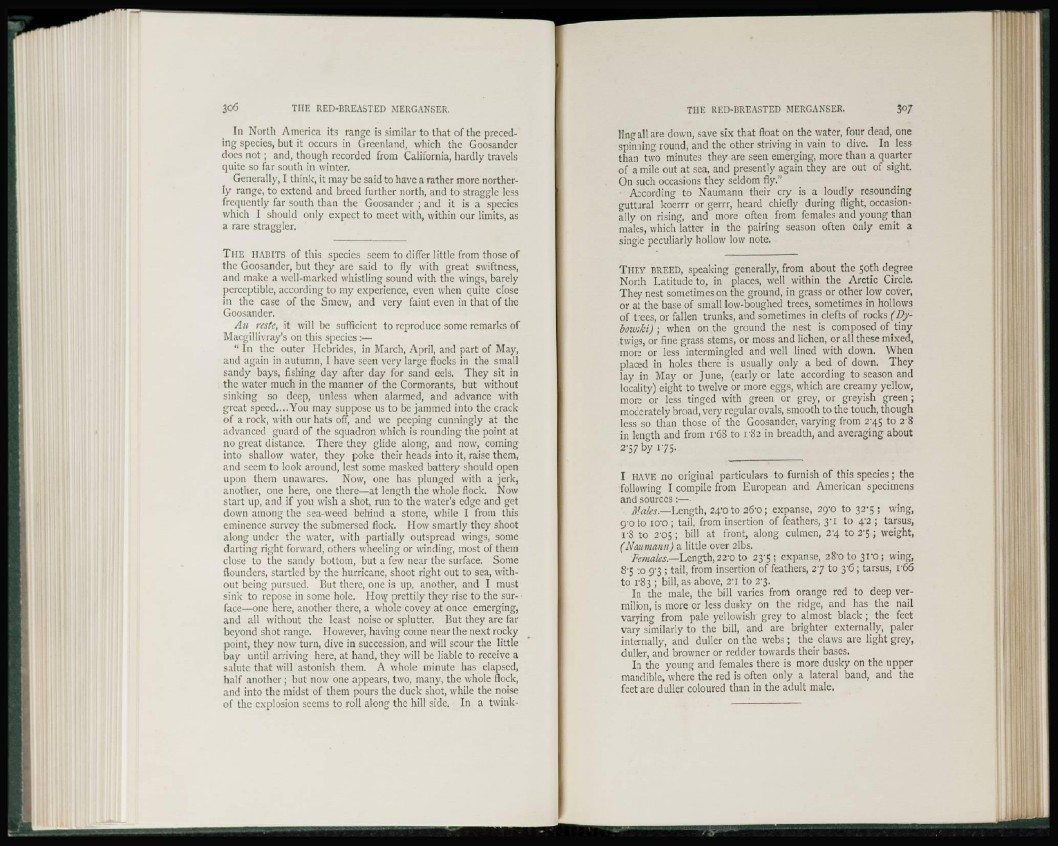
In North America its range is similar to that of the preceding
species, but it occurs in Greenland, which the Goosander
docs not ; and, though recorded from California, hardly travels
quite so far south in winter.
Generally, I think, it may be said to have a rather more northerly
range, to extend and breed further north, and to straggle less
frequently far south than the Goosander ; and it is a species
which I should only expect to meet with, within our limits, as
a rare straggler.
THE HABITS of this species seem to differ little from those of
the Goosander, but they are said to fly with great swiftness,
and make a well-marked whistling sound with the wings, barely
perceptible, according to my experience, even when quite close
in the case of the Smew, and very faint even in that of the
Goosander.
Au reste, it will be sufficient to reproduce some remarks of
Macgillivray's on this species :—
" In the outer Hebrides, in March, April, and part of May,
and again in autumn, I have seen very large flocks in the small
sandy bays, fishing day after day for sand eels. They sit in
the water much in the manner of the Cormorants, but without
sinking so deep, unless when alarmed, and advance with
great speed....You may suppose us to be jammed into the crack
of a rock, with our hats off, and we peeping cunningly at the
advanced guard of the squadron which is rounding the point at
no great distance. There they glide along, and now, coming
into shallow water, they poke their heads into it, raise them,
and seem to look around, lest some masked battery should open
upon them unawares. Now, one has plunged with a jerk,
another, one here, one there—at length the whole flock. Now
start up, and if you wish a shot, run to the water's edge and get
down among the sea-weed behind a stone, while I from this
eminence survey the submersed flock. How smartly they shoot
along under the water, with partially outspread wings, some
darting right forward, others wheeling or winding, most of them
close to the sandy bottom, but a few near the surface. Some
flounders, startled by the hurricane, shoot right out to sea, without
being pursued. But there, one is up, another, and I must
sink to repose in some hole. How prettily they rise to the surface—
one here, another there, a whole covey at once emerging,
and all without the least noise or splutter. But they are far
beyond shot range. However, having come near the next rocky
point, they now turn, dive in succession, and will scour the little
bay until arriving here, at hand, they will be liable to receive a
salute that will astonish them. A whole minute has elapsed,
half another ; but now one appears, two, many, the whole flock,
and into the midst of them pours the duck shot, while the noise
of the explosion seems to roll along the hill side, In a twinkling
all are down, save six that float on the water, four dead, one
spinning round, and the other striving in vain to dive. In less
than two minutes they are seen emerging, more than a quarter
of a mile out at sea, and presently again they are out of sight.
On such occasions they seldom fly,"
According to Naumann their cry is a loudly resounding
guttural kocrrr or gerrr, heard chiefly during flight, occasionally
on rising, and more often from females and young than
males, which latter in the pairing season often Only emit a
single peculiarly hollow low note.
THEY BREED, speaking generally, from about the 50th degree
North Latitude to, in places, well within the Arctic Circle.
They nest sometimes on the ground, in grass or other low cover,
or at the base of small low-boughed trees, sometimes in hollows
of trees, or fallen trunks, and sometimes in clefts of rocks (Dyboivski)
; when on the ground the nest is composed of tiny
twigs, or fine grass stems, or moss and lichen, or all these mixed,
more or less intermingled and well lined with down. When
placed in holes there is usually only a bed of down, They
lay in May or June, (early or late according to season and
locality) eight to twelve or more eggs, which are creamy yellow,
more or less tinged with green or grey, or greyish green ;
moderately broad, very regular ovals, smooth to the touch, though
less so than those of the Goosander, varying from 2-45 to 28
in length and from i-6S to 1*82 in breadth, and averaging about
2-57 by 175.
I HAVE no original particulars to furnish of this species ; the
following I compile from European and American specimens
and sources :—
Males.—Length, 24*0 to 26'0 ; expanse, 29*0 to 32-5 ; wing,
9"0 to io-o ; tail, from insertion of feathers, 31 to 4'2 ; tarsus,
1*8 to 2'05 ; bill at front, along culmen, 2*4 to 2'5 ; weight,
(Naumann) a little over 2lbs.
Females.—Length, 22-o to 23*5; expanse, 28*0 to 31*0; wing,
8'5 to 9'3 ; tail, from insertion of feathers, 27 to 3'6; tarsus, r66
to 1*83 ; bill, as above, 2*1 to 2"3.
In the male, the bill varies from orange red to deep vermilion,
is more or less dusky on the ridge, and has the nail
varying from pale yellowish grey to almost black ; the feet
vary similarly to the bill, and are brighter externally, paler
internally, and duller on the webs ; the claws are light grey,
duller, and browner or redder towards their bases.
In the young and females there is more dusky on the upper
mandible, where the red is often only a lateral band, and the
feet are duller coloured than in the adult male.